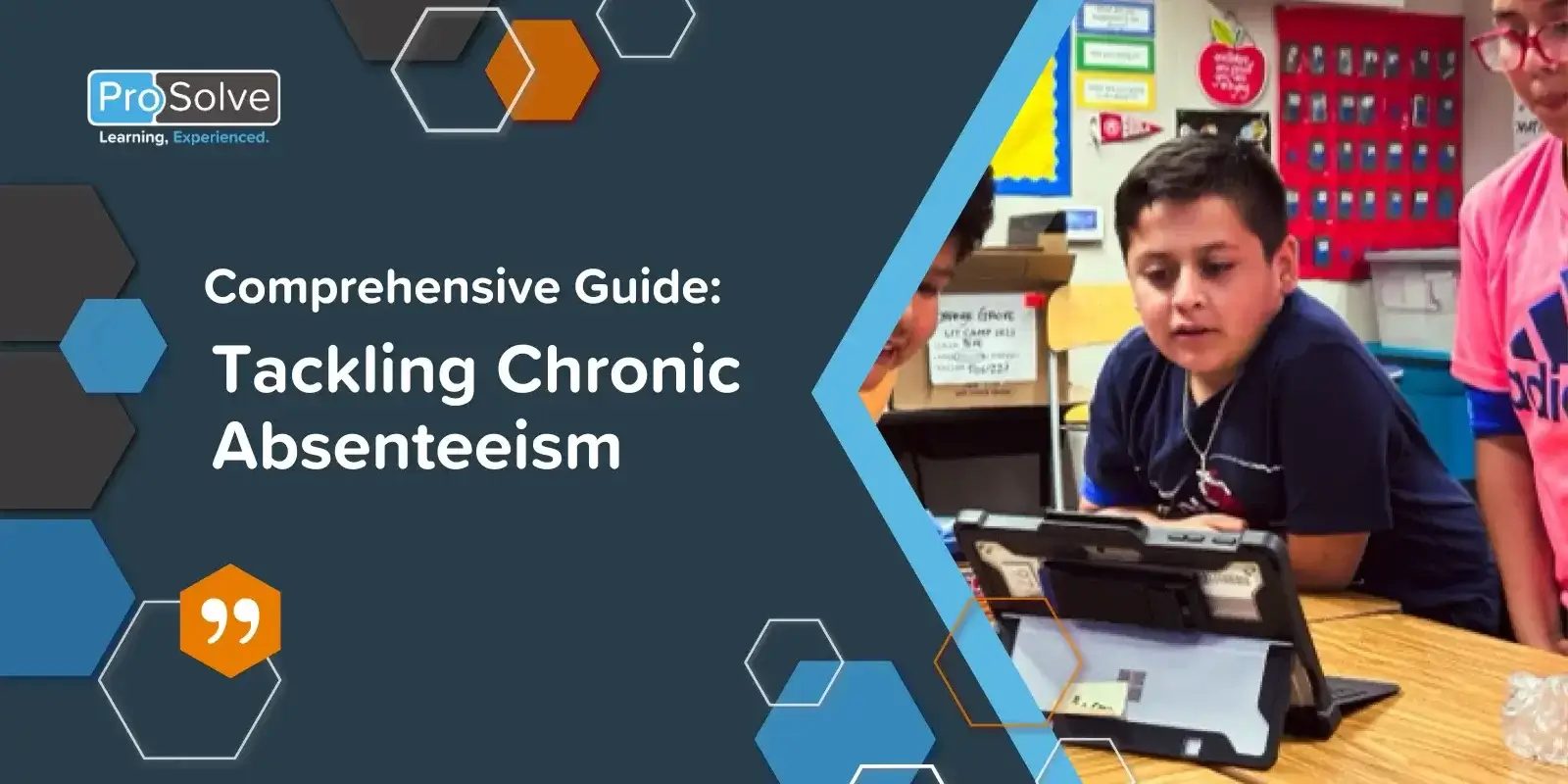Tackling Chronic Absenteeism in K-12 Education: A Comprehensive Guide

In K-12 education, chronic absenteeism is one of the most pressing issues to student success. This has far-reaching implications on individual student achievement and the broader educational system.
Chronic absenteeism, defined as missing 10% or more of school days for any reason, is a key barrier to learning, social-emotional wellness, and future success.
Consider this compelling statistic: Since the reopening of schools post-pandemic, over a quarter of students across the United States were chronically absent during the 2021-22 school year, up significantly from 15% prior to the pandemic. This stark increase highlights a troubling trend that educators and policymakers are grappling with nationwide.
Understanding the multifaceted nature of chronic absenteeism, its impacts on student achievement, and the broader implications for school districts is crucial. Equally important is exploring innovative solutions to effectively address this challenge.
This article explores this critical issue, offering insights and introducing a comprehensive resource developed by ProSolve to tackles this topic head-on. Join us as we unpack the complexities of chronic absenteeism and discover strategies to increase attendance by increasing engagement and belonging.
Understanding Chronic Absenteeism
Definition and Criteria
Chronic absenteeism in K-12 education is defined as the consistent absence of a student from school. The typical criteria for chronic absenteeism is a student missing at least 10% of school days in a given school year, regardless of whether these absences are excused or unexcused. This threshold, equating to about 18 days in a typical 180-day school year, is a critical metric educators and policymakers use to identify the risk of students falling behind academically.
Historical Perspective
Historically, school absenteeism has always been a concern, but the patterns and rates have increased over the years. Before the COVID-19 pandemic, chronic absenteeism was recognized but not as widespread of a concern as it is today. The national rate of chronic absenteeism was significantly lower prior to the pandemic. It's important to note that tracking and reporting methods for absenteeism have varied over time and across regions, which can impact the ability to make direct historical comparisons.
The evolution of chronic absenteeism rates has been influenced by various factors, including changes in public health issues, socioeconomic conditions, and educational policy shifts. In recent years, particularly with the onset of the COVID-19 pandemic, there has been a marked increase in chronic absenteeism rates. This rise is attributed to a complex mix of factors, including health concerns, shifts to remote learning, and the pandemic's broader social and emotional impacts on students and families.
The understanding of chronic absenteeism has also evolved. It's now seen not just as a matter of truancy or student disengagement but as a symptom of broader challenges that students may face, including health issues, family responsibilities, or systemic barriers. This clarity has led to nuanced approaches to addressing absenteeism, emphasizing understanding the underlying causes and providing targeted support to students and families.
Current Trends in Chronic Absenteeism
National and Regional Data
Chronic absenteeism in schools across the United States has significantly changed in recent years. For instance, during the 2021-22 school year, more than a quarter of students were chronically absent, missing at least 10% of the school year. This marked an increase from the pre-pandemic level, where only 15% of students fell into this category.
Different states exhibit varying rates, highlighting the regional disparities in absenteeism. In California, the rate increased dramatically from 12% in the 2018-19 school year to 30% in the 2021-22 school year.
Access our special report on the impact of chronic absenteeism in the K-12 education sector and discover comprehensive insights and solutions.
Impacts on Student Performance
Academic Consequences
Chronic absenteeism directly and profoundly impacts student learning, academic performance, and overall educational outcomes. Students who are frequently absent fall behind in their learning, each day missed is a missed opportunity to engage with new material and deepen knowledge.This can lead to a cycle of continuous catch-up, where students struggle to fill the gaps in their learning, often leading to frustration and disengagement from school.
Long-Term Effects
The consequences of chronic absenteeism stretch far beyond the classroom, setting a trajectory that can alter a student's life course. Students trapped in this cycle often face escalating disengagement, diminishing their prospects for academic success and graduation. The repercussions echo into their future, limiting career opportunities and earning potential, as high school dropouts are confronted with a more challenging job market and reduced financial security compared to graduates.
Beyond academics, the impact on social, emotional, and mental well-being is profound. Absenteeism erodes students' connections with their school community, peers, and educators, undermining their social skills, self-esteem, and sense of belonging. This disconnection fosters a broader societal issue, as the ripple effects of absenteeism extend into communities, fueling a cycle of disengagement and lost potential.
Chronic absenteeism is not just an educational hurdle; it's a societal epidemic with far-reaching consequences, emphasizing the critical need for timely, effective interventions.
Implications for School Ratings
Challenges for Schools
Schools face several challenges in managing chronic absenteeism. A primary challenge is identifying and addressing the underlying causes of absenteeism. These can range from health-related issues, family circumstances, and socio-economic factors to disengagement with the school curriculum. Each of these requires different strategies and resources, making the task complex and multifaceted.
- Resource Allocation Challenges: Schools often require additional support staff, like counselors and social workers, to tackle absenteeism effectively but face challenges due to limited or inadequate funding. Additionally, engaging families and communities in addressing absenteeism demands significant time and effort.
- Balancing Attendance Policies with Compassion: Schools grapple with enforcing attendance policies while maintaining compassion and understanding for individual student situations. Striking the right balance is crucial to avoid penalizing students who face genuine challenges without being overly lenient.
- Creating a Positive Educational Environment: Schools are focusing on strategies that foster an inclusive, engaging environment to combat absenteeism. This involves collaboration with parents and community, essential for nurturing a supportive educational atmosphere and promoting regular attendance.
In summary, chronic absenteeism poses significant challenges for schools regarding resource allocation, policy implementation, stakeholder engagement, and maintaining a positive educational environment. Addressing these challenges requires a comprehensive and empathetic approach that considers the diverse needs of students and the community.
Addressing the Challenge: Tailored Strategies and Forward-Thinking Interventions
Strategies and Interventions
Schools employ various strategies and interventions to combat chronic absenteeism, each tailored to address the multifaceted nature of the issue. Here are some common approaches:
- Data-Driven Identification: Schools use attendance data to identify students at risk of chronic absenteeism early on, enabling targeted interventions to prevent absenteeism from becoming a persistent issue.
- Engaging Families and Communities: Building strong partnerships with families and communities is crucial. Schools engage parents through meetings, workshops, and communication campaigns to emphasize the importance of regular attendance.
- Personalized Support: Recognizing that absenteeism often has complex causes, schools provide personalized support, including counseling services, healthcare access, academic tutoring, or mentoring programs.
- Positive School Climate: Creating an engaging and supportive environment encourages regular attendance, fostering strong relationships between teachers and students in a safe, inclusive atmosphere.
- Incentive Programs: Some schools implement reward systems to recognize and encourage good attendance, ranging from simple acknowledgments to elaborate point-based systems with tangible rewards.
- Develop High-Quality OST Opportunities: Schools create enriching out-of-school time programs, offering diverse activities to keep students engaged and connected to their educational journey.
- Cultivate Social and Emotional Learning: Integrating SEL into curriculums helps students manage emotions and social challenges, addressing underlying factors contributing to absenteeism.
- Foster The Whole Child: A holistic approach focusing on the 'whole child' addresses various aspects of student development, going beyond academic achievement to include physical, social, emotional, and mental well-being.
- Create a Supportive Environment: Schools work to build environments where students feel valued and understood, fostering a sense of belonging and safety, which is essential in reducing absenteeism.
In today's evolving educational landscape, these traditional strategies are augmented with innovative, engaging solutions. Integrating technology to make learning more dynamic, adopting experiential learning methods that bridge classroom lessons with real-world experiences, and implementing programs focused on social-emotional learning is pivotal in building student resilience and fostering a sense of school belonging.
Such creative approaches make education more relevant and enjoyable and align with the diverse needs of 21st-century learners, preparing them academically, emotionally, and socially for future challenges.
Empowering the Future: A Proactive Approach to Chronic Absenteeism in K-12 Education
In our exploration of chronic absenteeism within the K-12 educational sector, it's clear that this is a multifaceted challenge requiring a multifaceted response. Schools are implementing a mix of traditional and innovative strategies to engage students effectively and address the root causes of absenteeism. From data-driven identification and family engagement to fostering a positive school climate and integrating experiential learning, these approaches are pivotal in creating an educational environment that motivates and inspires students.
ProSolve is at the forefront of this transformative journey with our comprehensive special report, "High Quality OST Programs Help Mitigate Chronic Absenteeism Across The School Year." This resource delves deep into the complexities of absenteeism, presenting a rich analysis of current trends and introducing innovative strategies, particularly highlighting the impact of the QUEST curriculum.
Educators, policymakers, and educational stakeholders can access valuable insights and actionable solutions by downloading our special report. These strategies are not just about improving attendance rates but about reshaping the educational experience to make it more engaging, inclusive, and effective for every student.
Join ProSolve in reshaping the educational landscape. Together, we can ensure that every student is not only present but also engaged and empowered, paving the way for a future where they are fully prepared to meet the challenges and opportunities.




